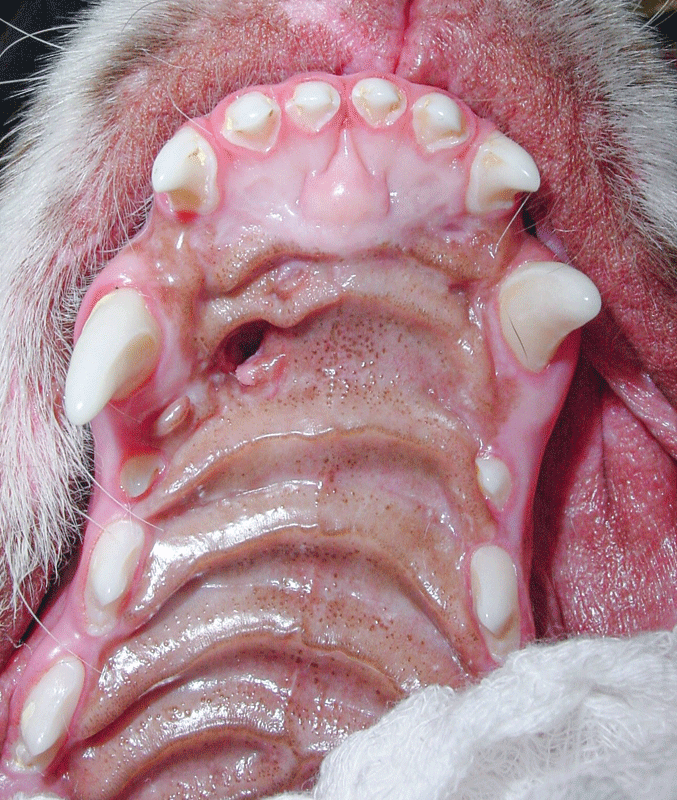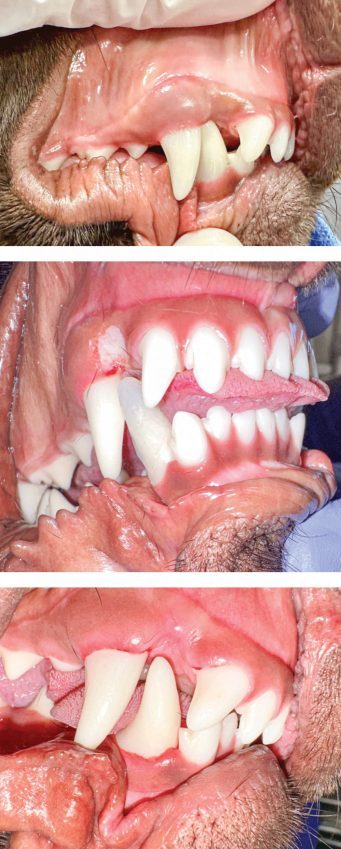Pet owners are often flabbergasted when they hear about veterinary orthodontic treatments. However, when a functionally important tooth is in the wrong location, this dental specialty can help guide the tooth to a proper position.
Veterinary ethics
Orthodontic procedures are not done in pets for cosmetic reasons. The American Veterinary Medical Association’s (AVMA) Code of Professional Conduct states correction of a conformational defect in a dog or cat is unethical, with the exception being where the abnormality affects the health or welfare of the animal.
Abnormally positioned teeth can cause tooth-to-tooth contact, which can result in concussive trauma to one or both teeth. Malocclusions can also result in tooth contact with soft tissue structures. An example of this is a Class 2 malocclusion, where the mandible is shorter than normal.
Similar trauma can occur in the absence of a Class 2 malocclusion if a mandibular canine tooth is in an abnormal position (linguoverted). This results in repetitive trauma to the palate from the tall mandibular canine teeth. This chronic trauma can result not only in soft tissue injury of the palate, but also in bone loss, which over time can result in an oronasal fistula (Figure 1).

development of an oronasal fistula. Photos courtesy Dr. John R. Lewis
The American Kennel Club’s (AKC) stance on correction of malocclusions is this: “Even procedures which are absolutely necessary to the health and comfort of a dog shall disqualify that dog from competition if the former had the incidental effect of changing or even improving the dog’s appearance, bite or gait.”
Addressing trauma
Let’s discuss one of the most common malocclusions I alluded to above: A Class 2 malocclusion, also known as “mandibular distoclusion,” has been previously referred to as “mandibular brachygnathism” and by the lay term “overbite.” This condition can be classified as mild, moderate, or severe, by which treatment decisions are affected.
There are three treatment options for permanent mandibular canine teeth that are causing palatal trauma.
- Extraction. The least desirable option is extraction of the mandibular canine(s) causing trauma. Since the mandibular canine teeth comprise such a large portion of the rostral mandible, extraction results in a narrow, less functional mandible, especially when both mandibular canine teeth require removal.
- Orthodontics. Another option is orthodontic movement of the mandibular canine teeth. Moving mandibular canine teeth to a more acceptable position usually involves creation of a passive orthodontic device, such as an inclined plane or composite extensions.
These options work well for mild and severe cases of mandibular distoclusion. Moderate Class 2 cases are not as good of candidates for passive orthodontic movement, since the malpositioned tooth is directly palatal to the maxillary canine tooth, and there is not an easy path for lateralization of the mandibular canine tooth.An inclined plane is attached to the maxillary canine and incisor teeth, resulting in a “sliding board” for the mandibular canine teeth to engage when the mouth is closed. The angulation of the inclined plane results in a tipping of the mandibular canine tooth to a position not causing palatal trauma.Composite extensions are a relatively recent addition to our orthodontic armamentarium, as described in the Journal of Veterinary Dentistry in 2018.2 This option has mostly replaced the use of inclined planes for passive movement of the mandibular canine teeth. Temporary crown extensions can be attached to the tips of the mandibular canines at an angle that will guide the canines to a more acceptable position (Figure 2).

Figure 2.Mild mandibular distoclusion cases are amenable to a passive orthodontic device called
composite crown extensions. 2A) Tooth 404 is occluding in an abnormal position. 2B)
Gingivoplasty and placement of bilateral composite tooth extensions will guide the tooth
to its normal diastema. 2C) One month later, the crown extension has been removed after
movement of the mandibular canine teeth to a more acceptable position.Once the teeth tip into the diastema, the composite can be removed unless a natural self-retaining position cannot be achieved due to the height of the crown. Even if the malocclusion is unilateral, these passive orthodontic devices must be placed bilaterally. Otherwise, the desired tooth movement will not occur—the jaw will merely drift toward the side of the device when the device is placed unilaterally. “Invisalign” type devices have also been described for use in veterinary patients with some success, but availability is limited.
- Crown reduction and pulp therapy. If owners are not interested in passive orthodontic movement or if movement would prove to be too complicated, another treatment option for maloccluding mandibular canine teeth is crown reduction and vital pulp therapy of the mandibular canine tooth.
Done under sterile conditions, a crosscut fissure bur is used to cut the height of tooth 404 approximately to the level of the adjacent third incisor cusp. Some pulp is removed, and a medicament is placed on the remaining pulp, followed by multiple restorative layers.
Success rates with this procedure approach 100 percent when done immediately after pulp exposure occurs.3
After performing crown reduction and vital pulp therapy of the mandibular canine tooth (or teeth), we assess and repair any palatal defects. Radiographic monitoring of the tooth is warranted to assess for loss of vitality of the tooth or loss of restorative material.
Composite crown extensions are a type of passive orthodontic device, meaning, engagement of the device is occurring only when the patient closes its mouth. Next month’s month column will discuss a case where active orthodontic movement (braces) would be appropriate.
John Lewis, VMD, DAVDC, Fellow, AVDC OMFS, practices at Veterinary Dentistry Specialists and teaches at Silo Academy Education Center, both in Chadds Ford, Pa.
References
- https://avdc.org/avdc-nomenclature/
- Storli SH, Menzies RA, Reiter AM. Assessment of Temporary Crown Extensions to Correct Linguoverted Mandibular Canine Teeth in 72 Client-Owned Dogs (2012-2016). J Vet Dent. 2018;35(2):103-113.
- Niemiec BA. Assessment of vital pulp therapy for nine complicated crown fractures and fifty-four crown reductions in dogs and cats. J Vet Dent. 2001;18(3):122-125.
